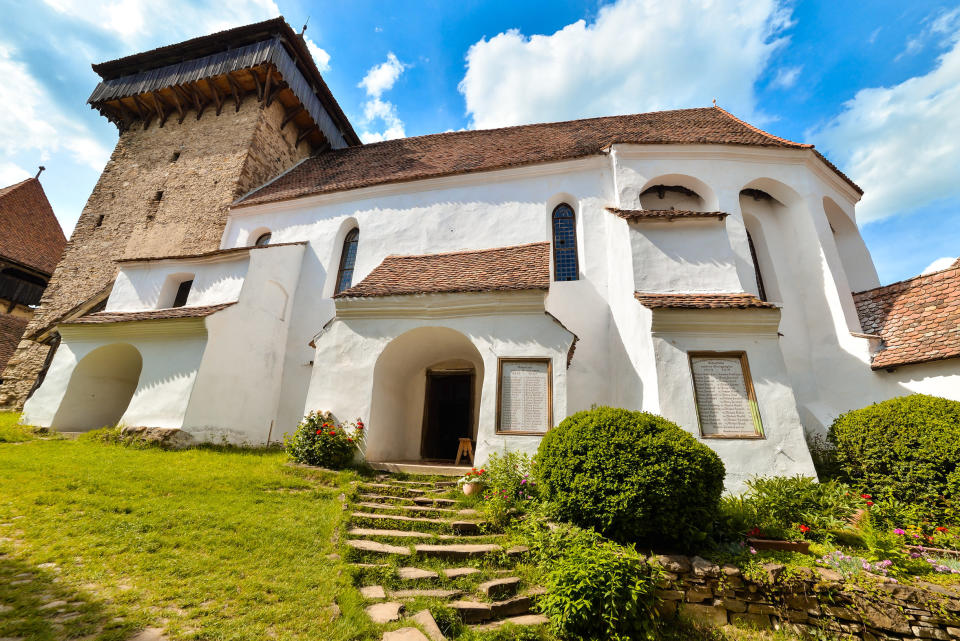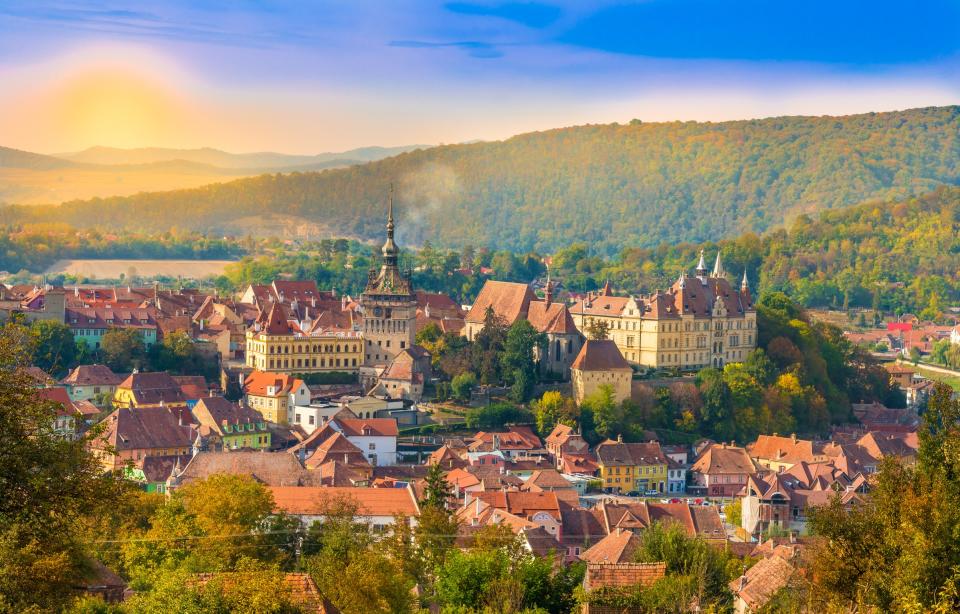Slow cycling through a country stuck in a time warp

The evening sun cast long shadows over Viscri’s main street, which sloped upwards towards the grand, white-walled, 13th-century church. In a scene that has been repeated every evening in summer since around 1150, a herd of cows nonchalantly blocked the road, having been guided down from the high meadows by a couple of brawny, leather-skinned men and their scruffy dog.
Every 20 yards or so, two or three of the cows peeled off, as if on automatic pilot, and went home to their respective barns tucked behind a long row of pastel-coloured houses and mooed goodnight to their bovine friends.

The Saxon village of Viscri is in southern Transylvania in Romania, but forget vampires and bloodsucking counts, unless you want a wooden souvenir to hang on the back of your loo door. This was just one stop on a new, long long-weekend “slow cycling” trip during which I would pedal sedately through pastures strewn with an amazing array of wildflowers, and amble along shaded woodland tracks and down country roads shared only with a horse and cart. I’d crest hills to find hamlets unchanged for hundreds of years except for thoroughly 21st-century guesthouses containing a comfy bed, power shower and Wi-Fi. Food would be not so much “farm to fork” as “garden to spoon”: one day I had to pause during breakfast while the cow was milked a few yards away.
My route was devised by Oli Broom, a 36-year-old cricket-mad Briton who cycled all the way to the Ashes in Australia in 2009 and fell in love with Romania en route. He recently set up slow-cycling holidays in Transylvania, where the emphasis is on experiencing local food and culture, not madly dashing from A to B in a blaze of Lycra.
15 alternatives to another predictable Med holiday
Saxons arrived in Transylvania from what is now western Germany in the mid-12th century at the request of King Geza II, who wanted to counter the influence of tribes pressing from the east. The Saxons prospered, guarding their traditions, speaking a form of Luxembourgish, farming and building impressive fortified churches, some now with World Heritage Organisation listing and much beloved of Prince Charles. When the Ceausescu regime collapsed in 1989, around 90 per cent of the Saxons fled west to a new life in Germany, abandoning whole villages to the Romanians and gypsies who live in them now.
I started in Cund, about a four-hour drive north west of Bucharest. On a hot summer morning, the sun glinted off the striking Saxon church, which, now congregationless, is shut up and guarded by geese.
Oli passed me onto local guide Sergiu Paca, who, like several people I met that week, spoke flawless English that he learnt from Hollywood movies. Another such man was the village cheese maker who told me about his thwarted plans to expand his fledgling empire. “I wanted to build something bigger, but my mother said it would take over her aubergine patch.”
Cycling here isn’t that tough, but you’re out most of the day and there are enough uphill sections to warrant a decent level of fitness before you arrive. Couch potatoes need not apply, but on the other hand you don’t need to be Chris Froome either.
The track from Cund climbed gently past fields of sheep with steep, smooth grassy banks off to the left and pockets of windblown trees on top, silhouetted under a cloudless blue sky. It ran down into the small town of Dumbraveni, where little stirred in the heat of the day except a lady selling watermelons in the shade of the grand Armenian church, highlighting another minority that had also moved on.

After lunch we pedalled about eight miles on to Biertan, which has one of the most impressive Saxon churches in the area, protected by three sets of walls. A local tradition involved married couples who were going through a rough patch being locked up in one of its towers until they had sorted out their differences, even if that took weeks. It’s said that over three centuries there was only one recorded divorce… but no mention of how many murders.
Our rest for the night was in a home converted into a luxurious guesthouse by its Italian owner in the neighbouring village of Copsa Mare. Three old women sat on the main street outside overseeing coming and goings and admiring the newly paved pavement, but wondering if it would actually last a winter when temperatures plummeted to -30C. No cars drove down the road, just an occasional horse and cart. The only sound was that of people chatting and laughing on their doorsteps and swallows chirping overhead.

In the evening – after a dinner of smoked aubergines, soup, fried pork and divine chocolate cake – we hitched a lift to the top of the rolling hills outside the village with views over to the Carpathian Mountains. At the summit we stopped at the dilapidated shack of a Hungarian-speaking shepherd who spent summers looking after his flock with a ragged but fierce array of sheep dogs and a menagerie of puppies, pigs and cats. He offered us some cheese he’d made that day and talked about the bears and wolves that inhabited the area. “I’m not worried about wolves taking my sheep. As long as the bears are around, wolves aren’t a problem.”
The next morning, after a breakfast of yogurt and bee pollen, we passed through the ramparts and turrets of Sighisoara, birthplace of Vlad the Impaler and the legends of Dracula. It’s a pretty and interesting town, and Sergiu brought many tales to life as we wandered its narrow streets. From a monastery nearby we descended on our bikes through bucolic meadows, where the only sound was a deafening chorus of insects and where buzzards swooped down over straw bales. We cycled through woods of oak, beech and wild cherries – the latter loved by the brown bears – and scattered butterflies that danced on the path. On the other side we emerged into seemingly endless grassy pastures.

The path through the middle parted almost biblically and the air felt hot and tasted of hay. “Another 40 minutes till lunch,” said Sergiu. Forty-five minutes later he advised: “Just another 20 minutes.” I looked sceptically at him. “I’m just throwing out random numbers,” he said, laughing, before we eventually stopped for a picnic lunch of cheese, tomatoes, sausage, bread and elderflower cordial in the shade of a large pear tree, alone apart from a shepherd and his flock on their way down the valley.
Around the village of Mesendorf later that afternoon, the riot of wildflowers – purple viper’s grass, hairy flax, Siberian bellflower, Charterhouse pink and sword-leaved fleabane among them – was almost overpowering.
Sergiu and I set our bikes down, breathed in the scent of wild thyme and listened for corncrakes. If life has a pause button, this small corner of eastern Europe is as good a place as any to prop your bicycle up, sit back and give it a push.
How to do it
The Slow Cyclist (020 7060 4487; theslowcyclist.co.uk) offers five-night trips to Transylvania from £1,175 per person, which includes guiding, local transfers and accommodation with meals. Maximum group size, 12; next departure May 9.
Wizzair (wizzair.com) offers several flights a week between London Luton and the Transylvanian city of Cluj-Napoca. For those wanting to extend the trip to include a few days in Romania’s fascinating capital,
British Airways (0344 493 0787; ba.com) flies daily from London Heathrow to Bucharest.


